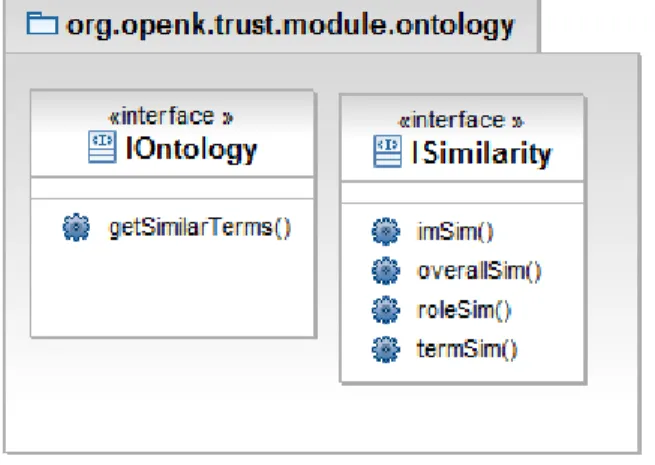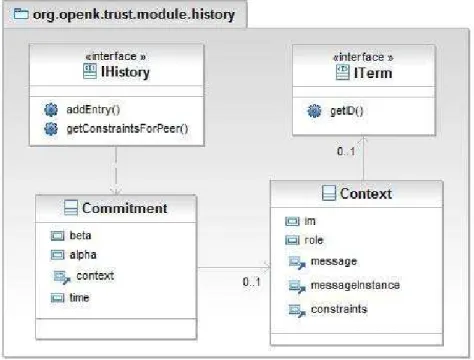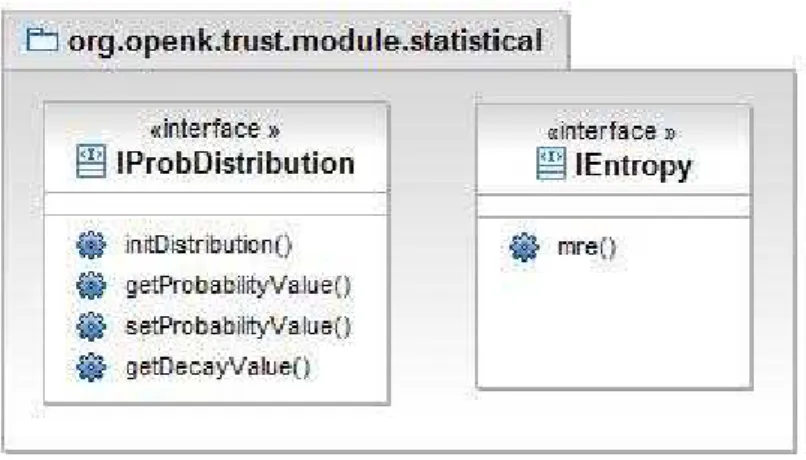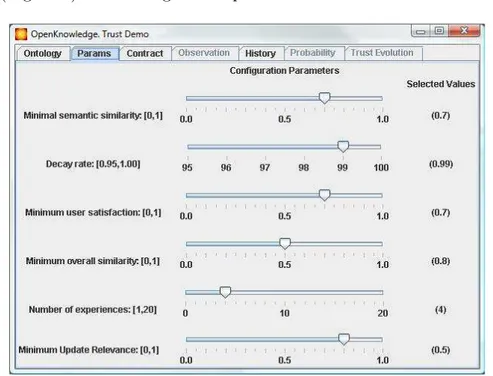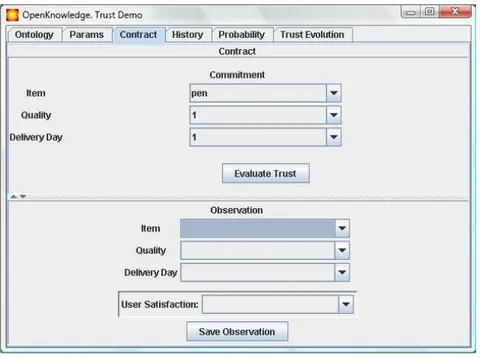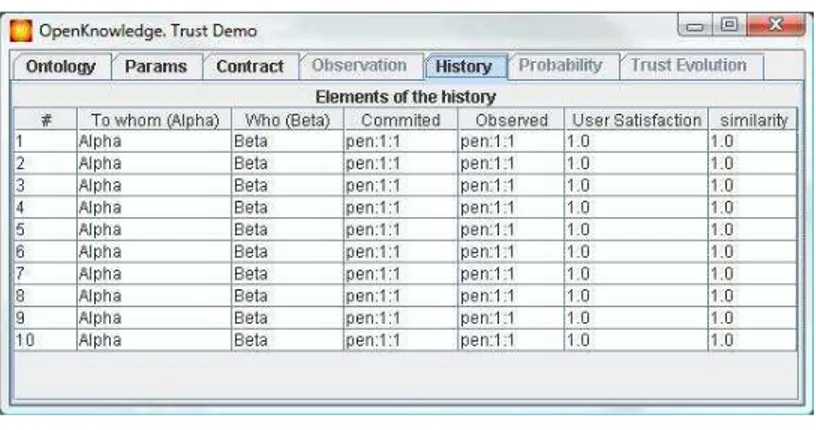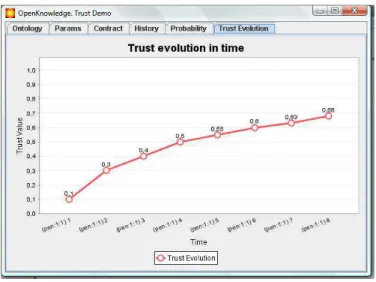UNIVERSITY
OF TRENTO
DEPARTMENT OF INFORMATION ENGINEERING AND COMPUTER SCIENCE
38050 Povo – Trento (Italy), Via Sommarive 14 http://www.disi.unitn.it
PLUG-IN COMPONENT SUPPORTING TRUST
Juan Pane, Carles Sierra, Adrián Perreau de Pinninck
and Pavel Shvaiko
April 2008
Technical Report # DISI-08-021
OpenKnowledge
FP6-027253
Plug-in component supporting trust
1Juan Pane1, Carles Sierra2, Adri´an Perreau de Pinninck2, Pavel Shvaiko1 1 University of Trento
{pane;pavel}@dit.unitn.it
2 IIIA(CSIC) Barcelona
{adrianp;sierra}@iiia.csic.es
Report Version: final
Report Preparation Date: 21/12/07 Classification: deliverable 4.8
Contract Start Date: 1.1.2006 Duration: 36 months
Project Co-ordinator: University of Edinburgh (David Robertson) Partners: IIIA(CSIC) Barcelona
Vrije Universiteit Amsterdam University of Edinburgh KMI, Open University University of Southampton University of Trento
1The originally planned title of this deliverable as from the project proposal was ”Trust and reputation evaluation plug-in”. However, this new title better reflects the current contents of the deliverable and needs of the project, and therefore, is used here.
Abstract
This document provides a brief documentation of the Trust com-ponent within the OpenKnowledge (OK) project. In particular, it discusses: (i) the Trust algorithms, (ii) the Trust component archi-tecture, (iii) the graphical user interface, and (iv) a concrete case study scenario.
1
Introduction
This deliverable describes the plug-in implementation of the trust compo-nent described in Deliverable 4.5 [1]. The deliverable is divided in two major sections. Section 2 explains the decisions taken when implementing the algo-rithms in Deliverable 4.5. The currently implemented version is a stand-alone one. This section also explains what visual interfaces have been implemented to interact with the plug-in. Section 3 explains the working of the algorithms in a concrete negotiation scenario.
2
Implementation
2.1
Trust model implementation
The following web site http://www.few.vu.nl/OK/wiki/ provides the Open-Knowledge (OK) client installation guidelines, while the source code is avail-able at the project revision (subversion) control system - SVN: http:// fountain.ecs.soton.ac.uk/ok/repos/modules/trust/trunk2.
The Trust model has been implemented as a separate module from the Open Knowledge Kernel [2]. This decision was taken considering that the computation of Trust values requires a fair amount of computational re-sources, so leaving the kernel as lightweight as possible. Only those peers that require the sophisticated computation of trust because, for example, they are running sensitive interaction models (IM) [3] like buying and selling goods, or they run on mobile devices, can choose to use the trust module as a service.
The interface of the trust module is:
public interface ITrust { //Trust interface
public double getTrust(String peerID, Commitment commit); }
2Authorization required, contact David Dupplaw ([email protected]) for an account set up.
where the first argument peerID of the getTrust function is the identity of the peer of which we want to assess the trust about a particular yet to be signed commitment3 commit. The commitment commit is a 4-tuple
(β, α, him, r, m, ϕ, cmi, t) where him, r, m, ϕ, cmi is the context. This means
that β commits to α to play role r in interaction model im and, as part of playing the role r, to send a particular message m instantiated as ϕ, in a manner determined by the set of constraints cm, the commitment being
made at time t, see [1] for details.
Each peer α has a local history Mα of interactions with other peers βs.
Each entry µ in Mαis a 4-tuple hC, ϕ00, g, di, where C is the previously defined
commitment, ϕ00 is the observation of what actually was done by β, g is in
0,1 and can denote correct ”1” or failed ”0” execution of the im, and d is
α’s rating, this is, how happy the user was with the actual observation of the
commitment.
Trust is calculated on demand following Algorithm 1 in this section (im-ported from Deliverable 4.5 [1] for the purpose of completeness of the deliv-erable). The main steps in the algorithm are:
1. (lines 1 to 6) build the F ocus set, this is, the set of all terms ϕ0from the
local Ontology O that are similar enough (over a defined threshold ν) to the current commitment ϕ. Where the similarity function is defined as: Sim(ϕ, ϕ0) = ( 1 if ϕ = ϕ0 e−κ1l· eκ2h−e−κ2h eκ2h+e−κ2h otherwise (1) where l is the length (i.e; number of hops) of the shortest path between the concepts, h is the depth of the deepest concept subsuming both concepts, and κ1 and κ2 are parameters balancing the contribution of
the shortest path length and the depth, respectively [4].
2. (lines 7 to 9) calculate the decay distribution D. Where D is the default probability distribution when there are no relevant experiences.
3. (lines 10 to 13) calculate Hβ, which is the set of commitments that the
peer β has successfully fulfilled, according to the user rating d of the observation ϕ00.
4. (lines 14 to 21) measure the ability of β of doing ϕ, considering the set
Hβ of what he has successfully done in the past.
3We follow Deliverable 4.5 in that a commitment is any ontological expression that can be observable. Not all ontological expressions are observable. In that sense, a concept (element in the vocabulary, e.g. Cow) in the ontology can not be the subject of a com-mitment, but a contract or a proposition whose truth can be verified can be (e.g. a cow is a mammal).
Algorithm 1 function Trust(α, β, him, r, m, ϕ, cmi)
Require: O {the peer finite local ontology}
Require: κ1, κ2: Real [Default 1.0] {parameters of the similarity function} Require: η : [0, 1] [Default 0.8] {min. sem. similarity in the computation} Require: ν : [0, 1] [Default 0.95] {decay parameter}
Require: ζ : [0, 1] [Default 0.7] {minimum satisfaction} Require: ω : [0, 1] [Default 0.1] {minimum overall similarity} Require: λ : [0, 1] [Default 0.1] {minimum update relevance}
Require: nex : N [Default 6] {number of experiences to be highly confident}
Require: Prefer : T erms(O)×{ϕ} → [0, 1] [Default Prefer(x, y) = if x = y then 1 else 0]
{a prob. dist. for preference of terms over ϕ represented as a vector}
Require: Mα⊆ M {α’s log of experiences sorted by time} Ensure: T rust(α, β, hIM, r, m, ϕ, cmi) ∈ [0, 1]
1: F ocus ← ∅
2: for all ϕ0 in Terms(O) do 3: if Simτ(ϕ0, ϕ, κ1, κ2) ≥ η then 4: F ocus ← F ocus ∪ {ϕ0} 5: end if
6: end for{we assume finiteness of Terms(O)} 7: for all ϕ0 in Focus do
8: D(ϕ0 | ϕ) ← 1/size(F ocus) 9: end for
10: Hβ= ∅
11: for all µ = hP C, ϕ00, 1, diin M α
and hCommit(β, , him, r, m, ϕ0, c0i, t)i ∈ P C with d ≥ ζ do 12: Hβ= c0∪ Hβ 13: end for 14: M atch ← 1 15: for all φ ∈ cmdo 16: M AX ← 0 17: for all φ0∈ H β do
18: M AX ← max{M AX, Sim(φ, φ0)}
19: end for 20: M atch ← M AX · M atch 21: end for 22: t ← 0; Pt= D 23: for all µ = hP C, ϕ00, 1, di in M α
and hCommit(β, , him, r, m, ϕc, cmi, t)i ∈ P C do 24: if Sim(ϕc, ϕ) ≥ ω then
25: for all ϕ0 in Focus do
26: S ← (1− | Sim(ϕ00, ϕ c) − Sim(ϕ0, ϕ) |) · Sim(ϕc, ϕ) 27: if S ≥ λ then 28: Q(ϕ0 | ϕ) ← M atch·(Pt(ϕ0|ϕ)+1/(n ex·|Q|)·S ·(1−Pt(ϕ0|ϕ))) {Constraints to satisfy} 29: end if 30: end for
31: Pt+1← (1 − ν)D + ν · M RE(Pt, Q) {MRE is the Min. relative entropy from Pt satisfying Q}
32: end if 33: t ← t + 1
34: end for 35: T ← 0
36: for all ϕ0 in Focus do
37: T ← T + P ref er(ϕ0, ϕ) ∗ Pt−1(ϕ0| ϕ) 38: end for
39: return T
5. (lines 22 to 34) update the probability distribution P , considering the entries in the local history Mα that are similar enough (over a given
threshold ω), to the current commitment.
6. (lines 35 to 39) calculate the final trust value considering the proba-bility of the terms in the set F ocus.
2.1.1 Packages in the Trust Module
The implementation of the trust module is divided in 3 main packages:
Figure 1: Class diagram for Ontology package.
1. org.openk.trust.module.ontology: This package interfaces with the local representation of the ontology in the peer. Figure 2.1.1 shows the class diagram of this package. The interfaces that should be imple-mented are:
• IOntology: which is required to obtain all the similar terms
needed by Algorithm 1 and defined by the getSimilarterms() function in the interface;
• ISimilarity: defines the similarity functions also needed by
Al-gorithm 1. imSim() computes the similarity between interac-tion models, roleSim() computes the similarity between roles, termSim() computes the similarity between terms that a peer can commit to, and overallSim() defines an aggregation function of all the other similarity functions, in order to obtain a unique over-all similarity score, for more details see Deliverable 4.5 [1].
2. org.openk.trust.module.history: This package interfaces with the local representation of history Mα of the peer. Each peer is free to
implement its local history as preferred, and then implement the inter-faces in this package to interact with the so defined local representa-tion. Figure 2 shows the class diagram of this package; the classes in this package are:
Figure 2: Class diagram for History package.
• IHistory: is the bridge between the local implementation of the
history of the peer and the Trust module, it should at least provide functionalities for inserting (addEntry()) and retrieving entries (getConstraintsForPeer()) from Mα.
• ITerm: represents the capabilities or constraints that one peer can
commit to, and therefore, can later be observed. The getID() function obtains the identifier of the Term.
• Commitment: is the commitment C defined in Section 2.1. This is,
beta commits to alpha to fulfill some action defined in context in time t.
• Context: is the context a particular peer commits to fulfill as
defined in Section 2.1. This means that a peer commits to an-other peer to play role in interaction model im and, as part of playing the role, to send a particular message instantiated as messageinstance, in a manner determined by the set of constraints, see [1] for details.
3. org.openk.trust.module.statistical: This package defines the sta-tistical functions that are the base of the Trust calculation. Figure 2
Figure 3: Class diagram for package Statistical package.
shows the class diagram of this package. The interfaces in this package are:
Figure 4: Ontology of a local peer.
• IProDistribution: represents the probability distribution P that
changes during time. It manages the conditional probabilities de-fined in Deliverable 4.5 [1] and the decay D, see Algorithm 1. The defined functions are: iniDistribution() that initializes the probability and decay distribution, getProbabilityValue() returns the probability for a given term, setProbabilityValue() sets a new probability for a given term, and getDecayValue() returns the decay value for a given term in the probability distri-bution.
• IEntropy: defines the update function mre() (minimum relative
entropy) for the probability distribution Pt used in Algorithm 1.
2.2
Visual interfaces
The implementation of the Trust module includes a Graphical User Interface (GUI) to show the capabilities and the different components of the mod-ule. The source code of the Visual interface is located at org.openk.trust.visual
within the SVN project. The GUI is composed of several tabs, which intend to show the parameters, behaviour and results. The tabs are:
1. Ontology: shows a graphical representation of the local ontology of the current peer (Figure 4). It defines possible terms that can be used in the interaction models (IM).
2. Parameters: shows the parameters and the default values of the Trust module, which can be customized in order to change its behaviour (Figure 5). The configuration parameters are:
Figure 5: Parameters of the Trust Module.
• ν: minimum semantic similarity required between a term of the
ontology and the commitment under analysis to consider the term to be a part of the F ocus.
• v: (decay rate) sets how slow, 1 − v, P goes back to the default
probability distribution D. This is, if no observation happens during a unit interval of time, the new probability distribution is
calculated as: Pt+1 = (1 − v) · D + v · Pt, see Deliverable 4.5 [1]
for details.
• minimum user satisfaction required to consider that an entry in
the history, for a given peer β, was good enough, and therefore should be considered in order to assess the capabilities of β. The peer will be considered capable of fulfilling those contracts close enough to commitments in the past with a degree of satisfaction over the value of this parameter.
• minimum overall similarity between commitments in the history Mα, and the current commitment, to consider that one
commit-ment in Mα is meaningful enough to affect the assessment of P .
• Nex: number of experiences with a peer β about a certain
com-mitment ϕ, necessary to fully consider the influence of a new ex-perience to assess P .
• λ: minimum update relevance, i.e; minimal semantic similarity
be-tween the current commitment, the expected and observed terms in one entry of the history, and one term in the focus, to consider that the considered term in the focus should change the probabil-ity distribution.
Figure 6: A contract to be tested.
3. Contract: shows the commitment ϕ that a peer β has signed, or is about to sign, and for which assessment we can use the Trust module. This tab (Figure 6) also lets the user define the observation of the
Figure 7: History of the observed contracts for the current peer. commitment ϕ0. Once the user defines ϕ0, the tuple hϕ, ϕ0i can be
stored in the history Mα of the observed commitments for β.
4. History: shows a subset of attributes of each entry in the history Mα,
mainly the index or number of entry, the current peer α, the commit-ting peer β, the committed term ϕ, the observed term ϕ0, the user
satisfaction d, and the similarity between the committed and observed terms.
Figure 8: Evolution in time of the probability distribution.
5. Probability Distribution (P ): shows a chart of the Probability of the terms in the F ocus (Figure 8). The terms are arranged considering their similarity value with respect to ϕ. At each time step P changes considering the commitment and observation of the corresponding entry in Mα. The time line represents the evolution of P , by changing its
value on the sliding bar, it is possible to observe the corresponding P for a particular moment in time.
Figure 9: Evolution in time of the trust for the current commitment. 6. Trust Evolution: shows a chart with the evolution of the Trust, for
the given ϕ (written in the contract tab) in time (Figure 9). The time evolution is defined by the entries in Mα as before. The last point in
the chart represents the current Trust value for the given ϕ.
3
A negotiation scenario
This section illustrates the monitoring of the trust plug-in in a concrete buying/selling scenario. The lifecycle of an interaction is described from the point of view of a particular peer, named peer1.
1. peer1’s user decides if he/she wishes to play the role of a buyer in a
buying-selling interaction. He/she therefore inputs the following query
into the discovery service (DS):
Buying selling interaction
2. The DS returns a list of potentially suitable IMs, ranked according to various criteria such as (for details see Deliverable 4.5 [1]):
• How well the query of the user matches the keyword description
of the IM.
• Some evaluation of how popular the IM is.
• How many peers are already subscribed to the IM.
This process would naturally return a ranked list of IMs to peer1. Let
a(buyer, B) ::
ask(C, M a, M o, Y ) ⇒ a(seller, S) ←
need(C : car, M a : make, M o : model, Y : year) then price(C, M a, M o, Y, P ) ⇐ a(seller, S) then
commit(B, S, ccIM, payer, pay, price = P )
← buy(C, M a, M o, Y, P ) ⇒ a(seller, S) ← af f ord(C, P : P rice) owns(C, M a, M o, Y ) ← sold(C, P ) ⇐ a(seller, S)
a(seller, S) ::
ask(C, M a, M o, Y ) ⇐ a(buyer, B) then
price(C, M a, M o, Y, P ) ⇒ a(buyer, B) ← instock(C, M a, M o, Y, P ) buy(C, M a, M o, Y, P ) ⇐ a(buyer, B) then
commit(S, B, crrIM, sndr, snd, car = C; make = M a; mod = M o; yr = Y ) ← sold(C, P ) ⇒ a(buyer, B)
Figure 10: Buying-selling IM.
3. Given a concrete need that materialises into a desired contract ϕ that
peer1 would like to see signed with a seller. It looks for potential
partners to play the selling role in the interaction model and then ranks them according to their relative trust with respect to the desired ϕ. Let us call the selected one, peer2.
4. peer1 runs the interaction model with peer2 to try and reach ϕ. If the
agreement is feasible the contract is signed and a commitment is made to run another interaction model later on, in this example: execute, in order to execute the contract.
5. peer1 and peer2 run the execute interaction model and then the actual
ϕ0 is observed.
The trust algorithm is used in step 3 to select the best potential seller. We illustrate the previous behaviour on a scenario where the orders, oi, consist
of: oi = (yi, qi, di), where: yi is the type of item ordered (pens, pencils,
markers, highlighters), qi is the quality of the item (a number in [1..5]), and
di is the number of days to delivery the product (a number in [1..7]). Finally,
Figure 4 shows graphical representation of the peer ontology.
4
Conclusions and future work
This document has explained the implementation details and the application in a concrete scenario of the trust plug-in developed within the OpenKnowl-edge project. The current implementation is stand-alone in order to facilitate its validation. We developed a graphical user interface to facilitate the tuning of the trust parameters by the user of the plug-in as well as to help in the monitoring of the component execution. The requirements of the algorithms
are easy to be satisfied by the kernel (including historical data and parameter values). Thus, the integration with the kernel is among the next steps. Also, the use of the Trust plug-in in the two major case studies is currently being studied.
Two reputation models are currently being studied as well: a centralized and totally distributed. The distributed model is based in the current Trust model, where gossip can occur in order to learn the behaviour of a particular peer we never had interacted with before. The centralized model just keeps track of user behaviour and can be consulted when needed. The results of this use will be reported in subsequent deliverables.
References
[1] Giunchiglia, F., Sierra, C., McNeil, F., Osman, N., Siebes, R.:
Open-Knowledge Deliverable 4.5: Good Enough Answer Algorithms. http://
www.cisa.informatics.ed.ac.uk/OK/Deliverables/D4.5.pdf (2006) [2] Perreau de Pinninck, A., Dupplaw, D., Kotoulas, S., Siebes, R.: The
openknowledge kernel. International Journal of Applied Mathematics and Computer Sciences (IJAMCS) 4 (2007) 162–167
[3] Joseph, S., de Pinninck, A.P., Robertson, D., Sierra, C., Walton, C.: OpenKnowledge Deliverable 1.1: Interaction Model Language
Def-inition. http://www.cisa.informatics.ed.ac.uk/OK/Deliverables/
D1.1.pdf (2006)
[4] Li, Y., Bandar, Z.A., McLean, D.: An approach for measuring seman-tic similarity between words using multiple information sources. IEEE Transactions on Knowledge and Data Engineering 15 (2003) 871 – 882
